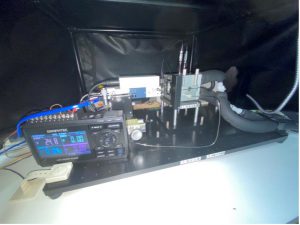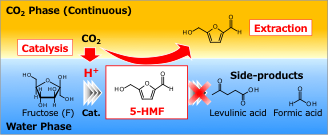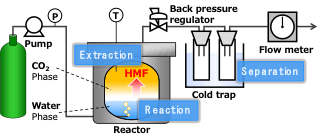Development of CO2separation and recovery technologies and effective utilization methods
Development of CO2 separation and recovery technologies and effective utilization methods
Technologies to separate and recover CO2 emitted into the atmosphere, and to convert and immobilize it into useful chemical products are indispensable to overcome two major issues that need to be solved in modern society: curbing global warming and breaking free from dependence on fossil resources. In this laboratory, we aim to solve these problems from a chemical engineering approach by making effective use of environmentally friendly solvents such as water and ionic liquids.
Technologies to separate and recover CO2 emitted into the atmosphere, and to convert and immobilize it into useful chemical products are indispensable to overcome two major issues that need to be solved in modern society: curbing global warming and breaking free from dependence on fossil resources. In this laboratory, we aim to solve these problems from a chemical engineering approach by making effective use of environmentally friendly solvents such as water and ionic liquids.
1.In-situ evaluation of CO2 dissolution behavior using Raman spectroscopy
The global average concentration of carbon dioxide (CO2), a potential cause of global warming, is said to have exceeded 400 ppm in 2015. In order to achieve the goal of reducing greenhouse gas emissions based on the Paris Agreement, it is impossible to simply curb emissions, and technology is needed to separate and recover CO2 that has already been emitted into the atmosphere.
In this laboratory, in collaboration with other universities and companies, we are aiming to develop technologies to utilize this atmospheric CO2. In particular, we are investigating the process of separating CO2 using liquid membranes made of gels containing ionic liquids, etc., and converting it directly into chemical products. We are currently analyzing the behavior of CO2 dissolution in solution by Raman spectroscopy and selecting the most suitable solvent species for the process.
1.In-situ evaluation of CO2 dissolution behavior using Raman spectroscopy
The global average concentration of carbon dioxide (CO2), a potential cause of global warming, is said to have exceeded 400 ppm in 2015. In order to achieve the goal of reducing greenhouse gas emissions based on the Paris Agreement, it is impossible to simply curb emissions, and technology is needed to separate and recover CO2 that has already been emitted into the atmosphere.
In this laboratory, in collaboration with other universities and companies, we are aiming to develop technologies to utilize this atmospheric CO2. In particular, we are investigating the process of separating CO2 using liquid membranes made of gels containing ionic liquids, etc., and converting it directly into chemical products. We are currently analyzing the behavior of CO2 dissolution in solution by Raman spectroscopy and selecting the most suitable solvent species for the process.


2.Synthesis Process of 5-HMF from Monosaccharides by CO2-Water Two-Phase System
The synthesis of chemical products from biomass, which is a recyclable resource, is one of the most important processes to break free from the dependence on fossil resources. In this laboratory, we are focusing on the synthesis of furan compounds such as 5-HMF (5-Hydroxymethyl furfural) from saccharides by catalytic synthesis and continuous extraction of the reaction products by CO2. In particular, by using a CO2-water two-phase system, we are aiming to optimize the conditions for the process in which CO2 contributes to both the acid catalyst and the product extractant, not only through actual reaction extraction but also through the development of physical properties.
2.Synthesis Process of 5-HMF from Monosaccharides by CO2-Water Two-Phase System
The synthesis of chemical products from biomass, which is a recyclable resource, is one of the most important processes to break free from the dependence on fossil resources. In this laboratory, we are focusing on the synthesis of furan compounds such as 5-HMF (5-Hydroxymethyl furfural) from saccharides by catalytic synthesis and continuous extraction of the reaction products by CO2. In particular, by using a CO2-water two-phase system, we are aiming to optimize the conditions for the process in which CO2 contributes to both the acid catalyst and the product extractant, not only through actual reaction extraction but also through the development of physical properties.


The extraction efficiency by CO2
is expected to be higher under low temperature and high pressure conditions. Therefore, we attempted to reduce the temperature of 5-HMF synthesis using a solid catalyst. From the experimental results, it was confirmed that the synthesis of 5-HMF was greatly enhanced at around 140°C in the reaction in water. Based on this result, we are currently optimizing the extraction of 5-HMF reaction at 140°C.